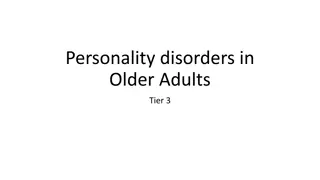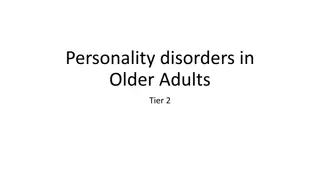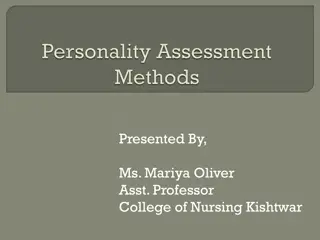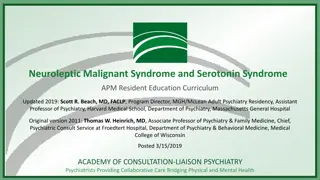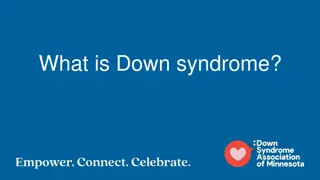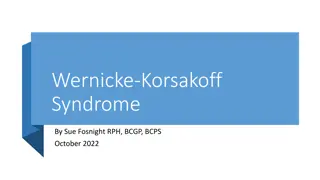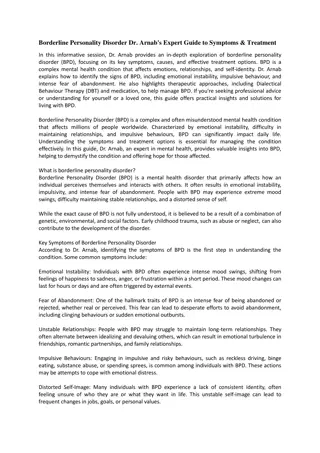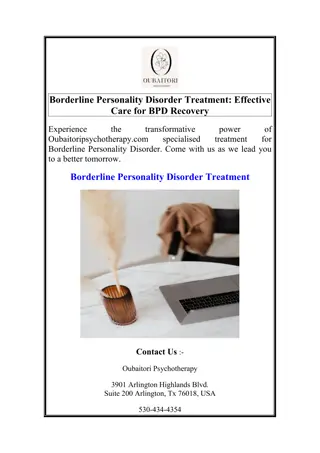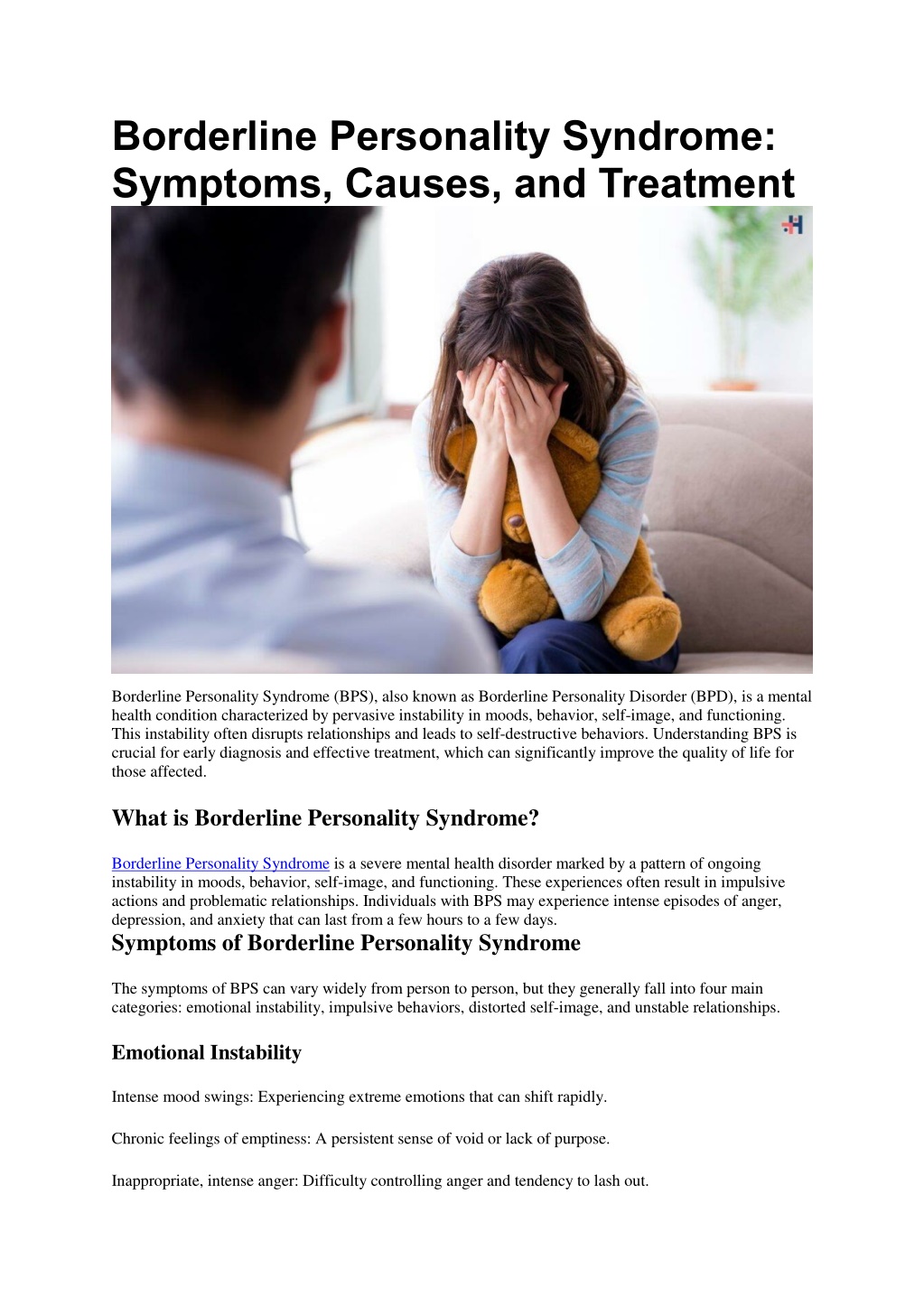
Borderline Personality Syndrome | healthcare
Understanding borderline personality syndrome is crucial for early diagnosis and effective treatment, which can significantly improve the quality of life for those affected.
Uploaded on | 0 Views
Download Presentation

Please find below an Image/Link to download the presentation.
The content on the website is provided AS IS for your information and personal use only. It may not be sold, licensed, or shared on other websites without obtaining consent from the author. Download presentation by click this link. If you encounter any issues during the download, it is possible that the publisher has removed the file from their server.
E N D
Presentation Transcript
Borderline Personality Syndrome: Symptoms, Causes, and Treatment Borderline Personality Syndrome (BPS), also known as Borderline Personality Disorder (BPD), is a mental health condition characterized by pervasive instability in moods, behavior, self-image, and functioning. This instability often disrupts relationships and leads to self-destructive behaviors. Understanding BPS is crucial for early diagnosis and effective treatment, which can significantly improve the quality of life for those affected. What is Borderline Personality Syndrome? Borderline Personality Syndrome is a severe mental health disorder marked by a pattern of ongoing instability in moods, behavior, self-image, and functioning. These experiences often result in impulsive actions and problematic relationships. Individuals with BPS may experience intense episodes of anger, depression, and anxiety that can last from a few hours to a few days. Symptoms of Borderline Personality Syndrome The symptoms of BPS can vary widely from person to person, but they generally fall into four main categories: emotional instability, impulsive behaviors, distorted self-image, and unstable relationships. Emotional Instability Intense mood swings: Experiencing extreme emotions that can shift rapidly. Chronic feelings of emptiness: A persistent sense of void or lack of purpose. Inappropriate, intense anger: Difficulty controlling anger and tendency to lash out.
Impulsive Behaviors Risky behaviors: Engaging in potentially harmful activities such as substance abuse, reckless driving, or binge eating. Self-harm: Deliberate self-injury as a way to cope with emotional pain. Suicidal tendencies: Recurrent suicidal behavior, gestures, or threats. Distorted Self-Image Unstable self-identity: A fluctuating sense of self and struggle to maintain a consistent identity. Feelings of dissociation: Feeling disconnected from oneself or the surroundings. Unstable Relationships Fear of abandonment: Intense fear of being abandoned by loved ones, leading to frantic efforts to avoid real or imagined separation. Unstable relationships: Swinging between extremes of idealization and devaluation in relationships. Causes of Borderline Personality Syndrome The exact cause of BPS is not fully understood, but it is believed to be the result of a combination of genetic, environmental, and social factors. Genetic Factors
Family history: Having a close family member with BPS or other mental health disorders increases the risk. Brain structure: Abnormalities in brain areas that control emotions and behavior regulation. Environmental Factors Trauma: Experiencing physical, emotional, or sexual abuse during childhood. Neglect: Growing up in an environment where emotional needs are not met. Social Factors Dysfunctional family dynamics: Experiencing instability and conflict in family relationships. Cultural influences: Societal and cultural pressures can contribute to the development of BPS. Diagnosis of Borderline Personality Syndrome Diagnosing BPS can be challenging due to its overlap with other mental health conditions such as depression, anxiety disorders, and bipolar disorder. A comprehensive evaluation by a mental health professional is necessary, which includes: Clinical Interview:Assessing the individual s symptoms, medical history, and family history. Psychological Testing: Using standardized assessment tools to identify specific symptoms and their severity. Observation: Monitoring behavior patterns over time. Treatment Options for Borderline Personality Syndrome
While there is no cure for BPS, various treatment options can help manage symptoms and improve the quality of life for those affected. Treatment typically involves a combination of psychotherapy, medication, and support from family and peers. Psychotherapy Dialectical Behavior Therapy (DBT): A type of cognitive-behavioral therapy specifically designed for BPS. It focuses on teaching coping skills to manage emotions, reduce self-destructive behaviors, and improve relationships. Cognitive Behavioral Therapy (CBT): Helps individuals identify and change negative thought patterns and behaviors. Schema-Focused Therapy: Combines elements of CBT with other therapeutic approaches to address deeply ingrained patterns of thinking and behavior. Medication Antidepressants: To help manage symptoms of depression and anxiety. Antipsychotics: To reduce symptoms of anger, impulsivity, and psychosis. Mood Stabilizers: To help control mood swings and reduce impulsive behaviors. Support Groups Peer Support: Joining a support group can provide a sense of community and understanding. Family Therapy: Involving family members in therapy to improve communication and reduce conflict. Coping Strategies for Living with Borderline Personality Syndrome In addition to professional treatment, individuals with BPS can benefit from various self-help strategies to manage their symptoms and improve their quality of life. Mindfulness Practices Meditation: Practicing mindfulness meditation can help manage stress and improve emotional regulation. Deep Breathing: Using deep breathing exercises to calm the mind and body during emotional distress. Healthy Lifestyle Choices Regular Exercise: Engaging in physical activity to boost mood and reduce anxiety. Balanced Diet: Eating a nutritious diet to support overall mental health. Adequate Sleep: Ensuring sufficient rest to help stabilize mood and improve emotional resilience. Building Healthy Relationships
Setting Boundaries: Learning to set and maintain healthy boundaries in relationships. Open Communication: Practicing effective communication skills to express needs and emotions clearly. Seeking Support: Reaching out to friends, family, or support groups for help and understanding. The Importance of Awareness and Education Raising awareness and educating the public about Borderline Personality Syndrome is crucial in reducing stigma and promoting early intervention. Misunderstandings and negative stereotypes about BPS can prevent individuals from seeking help and support. Education Campaigns Public Awareness: Launching campaigns to educate the public about the realities of BPS and the importance of mental health. School Programs: Implementing mental health education in schools to promote early awareness and intervention. Advocacy Mental Health Advocacy: Supporting policies and initiatives that promote mental health awareness and access to care. Fighting Stigma: Challenging negative stereotypes and promoting a more compassionate understanding of mental health disorders.
Conclusion Borderline Personality Syndrome is a complex and challenging mental health disorder, but with the right treatment and support, individuals can lead fulfilling lives. Understanding the symptoms, causes, and treatment options is the first step toward managing this condition effectively. By raising awareness and promoting education, we can create a more supportive environment for those affected by BPS, helping them to achieve stability and improved well-being. For anyone struggling with BPS or knowing someone who is, seeking professional help and support is crucial. Early intervention and consistent treatment can make a significant difference in managing symptoms and improving the overall quality of life. Find practical solutions to common challenges through our insightful articles on Healthcare 360 Magazine




